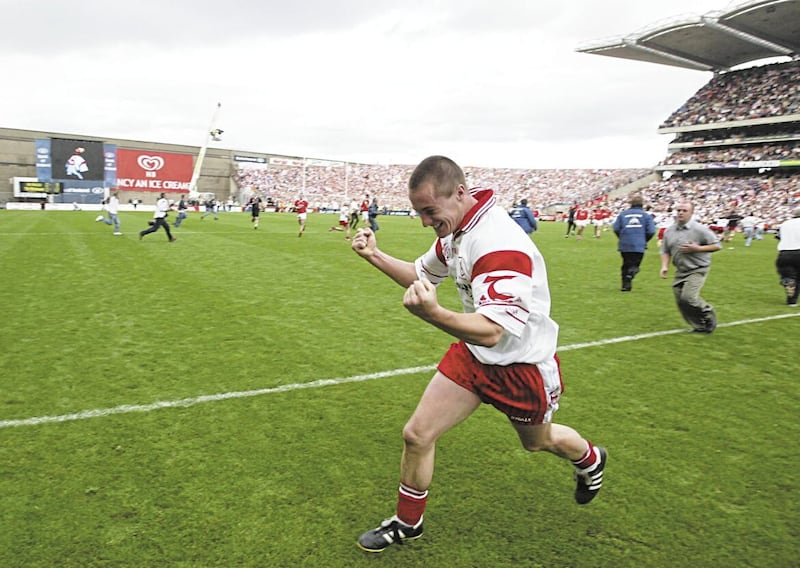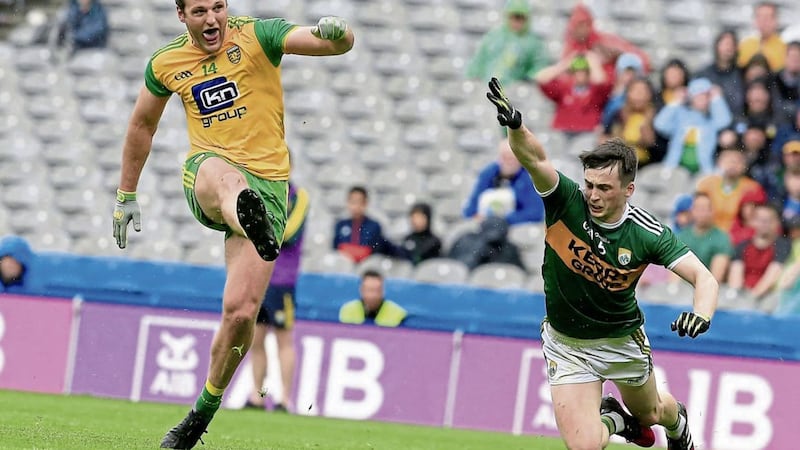IT’S difficult to remember a feel-good surge like it than the one prompted by Gaelic football’s new rule enhancements.
Probably the last surge of similar sentiment was standing among the heaving, optimistic masses in Belfast’s Royal Avenue in 1995 when American President Bill Clinton gave us all a gentle and charismatic push towards peace.
Dissent was virtually outlawed.
In any case, what’s not to love about a fair-minded, rationale peace accord?
And what’s not to love about how Gaelic football is shaping up in 2025?
When the Football Review Committee was put together, the upper echelons of the GAA choose well.
His post-match press conferences in Croke Park may have crushed many a reporter’s spirit when Dublin were on a roll, but the Zen-like Jim Gavin is the type of figure who commands instant respect.
The FRC needed some Kerry influence in there too.
Is there a more affable guy in the Kingdom than Eamonn Fitzmaurice? Doubtful.
The audacious attempt to revolutionise Gaelic football was off to a good start with men who had serious skin in the game.
And their ideas were generally good. Radical, but the good in them still outweighed the bad.
The ironic thing about Gaelic football up until this year was that it was never more sophisticated and skilled.
Forwards like Shane McGuigan, Conor McManus, Patrick McBrearty and David Clifford had perfected the tight, looping run to score.
How those marquee players went about their business was a sight to behold.
From a team perspective, everything had to be executed to perfection: moving the ball from side to side, patiently unpicking the lock, ensuring the angle of the attack suited the positioning of McGuigan, McManus et al.
And boom. Like a cheetah pouncing on its prey, they’d peel off the sideline – 10 or 15 metres was usually enough - and they’d fire over for a point when it didn’t seem possible.
There was nothing more skilled or sophisticated than observing how these scores were constructed.
The problem, however, was it sometimes took 40 passes to create the chance in the first place. It was just taking too damn long. Being sophisticated and skilled, while admirable, doesn’t necessarily make for a good spectacle.
And if the opposition is just as skilled and sophisticated, stalemate often ensues. And that’s what supporters were seeing, too often as it happens.
Many sports nuts would argue that field sport relies on mistakes and tactical looseness to produce an exciting spectacle.
Gaelic football had become too cerebral for its own good. The game needed some anarchy, a bit of shock treatment, players needed deskilled in order to learn new ones.
Another necessary evil was to disenfranchise the coaches on the sidelines.
For them, ‘controlling the controllables’ is a thing of the past. You can feel their pain as they watch on haplessly every Saturday evening and Sunday afternoon, praying the wind will just be as strong for their team in the second half.
In horrendous conditions at Corrigan Park a couple of weeks ago, Conor Hand of Antrim watched his scuffed effort hit the turf before it proceeded to spin over Clare’s crossbar for the unlikeliest of two-pointers, thanks in large part to a gale-force wind giving the ball wings.
Every game can live with the occasional fluke.
In the same game, a Clare forward was within tackling distance as Antrim broke out of their own half with the ball, but he was completely distracted by whether he was one of the three-up players and consequently took no notice of the play.
There aren’t many examples in field sport where a team is allowed to have more attacking players than what the opposition is defending with?
Is there not something fundamentally wrong with that notion - or must everything perish at the altar of bumping up the scores?
Nevertheless, when you strip it all back, the truth of the matter was Gaelic football needed a couple of nips and tucks because of tactical hegemony.
There were too many long passages of play where very little was happening in games. Whether the FRC’s rule enhancements have identified the right areas to carry out surgery remains to be seen.
As the Allianz National Football Leagues take time to breathe this weekend, the evidence in the opening two weeks is encouraging.
But you sense that this is the FRC’s honeymoon period and that there could a bit of turbulence coming down the tracks.
Some observers have been arguing the point for a while now that the game has become a Darwinian pursuit, where the athletic demands have become so great that the clever playmaker, the elusive number 11, has been erased.

Tyrone’s Brian McGuigan was one of the greatest footballers of his generation but even he acknowledged a few years ago that he would’ve struggled in the modern game because of the increasing physical demands.
In the emerging helter-skelter of the new version of Gaelic football, the running metrics for some players are significantly up. By how much, Donegal boss Jim McGuinness refused to reveal, claiming that it was “family business”.
Will the new game promote more long-distance runners than footballers? Quite possibly.
You might have a club player who can run all day but mightn’t be the best decision-maker in possession, but he’ll probably move up the pecking order under the new dispensation.
‘Give me a runner rather than a baller’.
Last weekend, I reported on the NFL Division One game between Armagh and Tyrone at the BOX-IT Athletic Grounds.
I assumed a seat in the overspill area in the back row of the main stand where you get a better feel for just how tough any given game is compared to the warm, sound-proof environs of the press box.
The speed with which Armagh counter-attacked was truly awesome. As they advanced, the orange jerseys were like galloping thoroughbreds primed for Cheltenham.
As we crept into wintry February.
You didn’t need to hear McGuinness’s words up in Ballybofey last Saturday night to realise that the regularity of explosive running in games is off the charts under the new rules.
A sixth substitution is a no-brainer. A seventh should be considered.
While the FRC will be inundated with data over the coming weeks: what works, what doesn’t work, there should be a similar statistical breakdown of muscle injuries incurred in the same period.
No wonder the returning Michael Murphy was held in reserve by Donegal last week.
Given the emerging physical demands on the inter-county footballer, the calendar needs revisited and stretched out by a few more weeks, otherwise there’ll be ravaged Championship squads up and down the country.
This surge of good feeling towards Gaelic football must be welcomed - but we shouldn’t blindly embrace it either just because we saw six goals and a handful of wind-assisted two-pointers on a breezy afternoon up the country.



